How To Create Your First Freelance Project Proposal: The Definitive Guide

Do you ever find yourself working for clients that pay you less than you’re worth?
Clients who don’t appreciate the work you do for them?
It’s painful to go through – I’ve been there too.
Here’s the deal:
You’re worth more. And you can land better-paying clients…
… Clients that truly appreciate the work you do (and reward you for it).
And in this guide, I’ll show you exactly how.
Inside you’ll learn:
- How to reframe your services so you can increase your rates without feeling icky.
- How to expand your service offering, and cross-sell clients.
- The art of the ‘discovery call’ and how to uncover your clients needs and objectives (so you can get more gigs).
- How to network with people who fit your ‘ideal customer’ and get hired by your perfect client in the process.
- How to craft a great project proposal – a free template is included in this post.
Note: The free template you’ll find in this post requires no opt-in and it’s all editable within Google Slides, so the software to edit it is completely free too.
This was a collaborative effort between myself, Adam and Nicola (Blogging Wizard’s editor). The final version is an example that Nicola used for her freelance songwriting business. And you can apply it to any other type of freelance business.
You’ll find the download link in part 2 of this post, where I’ll walk you through each slide.
But before we dive into the template, there are some important things to cover first. This advice will help you take your project proposals to the next level, and grow your biz faster.
Part 1 – What you need to know before you create your project proposal
There are countless other freelance writers. All vying for the same clients you are.
You want to set yourself apart from everyone else, right?
In this section, you’ll learn how to set yourself up for success, create a lasting impression, and sign up more clients.
Ready? Let’s do this!
#1 – Optimize your service offering with add-ons and extra services
Note: This advice has the potential to make you a lot more money, and increase the average lifetime value of each client.
One of the main reasons people hire writers is because they don’t have the time to do the job themselves.
So, doesn’t it make sense that there are other tasks they don’t have time for either?
… Promotion, design etc. Build up to a more complete service offering.
Leverage everything else you can do. Bundle your services, offer add-ons, related services.
Now let’s talk about exactly how to do this – with examples:
To start off, you simply need to re-frame your existing service offering to accurately convey the value that clients will receive.
For example, if you’re core offering is writing blog posts – highlight everything else that you’d do as part of that.
Which would likely include:
- Topic suggestions
- Topic research (references & data sources etc)
- Sourcing a royalty-free featured image
- Sourcing relevant images within the post (where necessary)
- Adding internal links to boost rankings & traffic to other posts
- Optimizing post for Google Search & Featured Snippets
- Sharing the post with your social media followers
And all of a sudden, what starts of as a standard article writing service, turns into something with a much higher perceived value.
And this means you can justify charging higher rates for the work you do – because all of this requires more expertise, and more time.
You may also want to consider offering a small discount for bulk orders.
But should you stop there?
Not a chance!
Now it’s time to put together your add-on services.
These are the extra little services you can add on top, that you’d charge extra for.
Big brands from fast food chains to electronic retailers go nuts with this stuff – because it works.
Yes, you may be charging more money, but you’ll be offering more value too.
You’ll be saving your clients time, and helping them get better results – that’s what matters, right?
Continuing with our previous example of writing blog posts, your add-ons could include:
- Design a custom featured image.
- Design a custom vertical Pinterest image.
- Create a content upgrade for the post.
- Adding the post into WordPress, with formatting optimized for readability.
- Advanced post formatting using a page builder such as Thrive Architect, or Elementor.
- Extra promotional activity (Quora answers, social bookmarking, etc).
- Managing Facebook ads for the promotion of that specific post.
- Writing the blog post announcement email to send to subscribers.
And because there is a lot more you can do as a freelance blogger, you may want to offer related services.
These would be offered as standalone services to enhance your service offering – giving you the option to cross-sell existing clients, or sign up new clients to these services.
A few related service examples could include:
- Writing email automation sequences
- Preparing a full month of blog post ideas
- Writing a full content strategy
- Audience persona research
- Social media management (these tools will help)
- Managing Facebook ads
- Content repurposing, for example turning posts into Slideshare presentations.
These are just examples, but the list is potentially endless.
Start with creating a list of all of the individual tasks (no matter how small), that you do for yourself as a freelance blogger.
Use that as your starting point because the chances are if you do something for your own blog, someone will hire you to do it for them.
#2 – Go beyond the template
Just like copywriting formulas, blogging or case study formats, a template has its place in your freelance writer’s toolbox.
Templates can and will work if you do more than fill in the blanks and hope for the best.
Templates do all the heavy lifting (and thinking) if you follow their lead. They can help you get your creative juices flowing.
But can templates fail? They sure can if you fill in the blanks and hope for the best.
There is no way of knowing how many freelance bloggers filled in the template before you.
We’ve all done it at some point. I’ve filled in the blanks. I felt like I sold myself short, but sent it out anyway and hoped for the best.
Instead, use this template as a creative guide. It will instruct you along the path to your next big blogging gig.
Here’s Adam’s take on templates:
Templates are a great time saver and they remove some of the resistance that stops us from taking action. Which is essential, especially in the early days.
But the reality is that they’re only a starting point. And there is no ‘one glove fits all’ template.
This means you really have to make templates your own. Customise them, put your stamp on them and tweak them to align with your brand/goals.
With or without a template, the process can be daunting. But, it’s a starting point from which you can build your confidence, save time, and get the ball rolling.
#3 – Start developing relationships with potential clients right away
If you want to take your freelance writing biz to the next level, you need to start developing relationships with potential clients.
Don’t wait for them to come to you, go to them.
Read their content. Comment on their posts. Engage with them on social media.
Or take it a step further and subscribe to their email list and reply to their emails – this is a great way to get into their inbox.
More influencers will reply than you might expect.
This puts you directly in-front of people who may be looking to hire a writer like you. And you can subtly mention that you’re a freelance writer for hire using your email signature.
You can create an email signature yourself, or you can use a tool like Wisestamp.com.
Why is this such a good idea?
It helps to humanize you, and enables people to easily learn more about you. It’s the first step in establishing trust.
I asked Adam for his thoughts on this:
If I see “freelance blogger for hire”, or something to that affect in an email signature, I usually check out their services, and some of their content.
Occasionally I ask them for more details about their service; pricing etc. And I make a note in a file for later (when I may ask for a proposal if it’s a more significant project).
Every so often I hire freelancers to help me out on various projects, or I’m asked for referrals, so I always refer back to this list before I even consider using a job site.
This is because the freelancer I hire is going to be more likely to have an understanding of my brand, and potentially have read posts on Blogging Wizard before – this makes a big difference.
While I don’t hire everyone, this puts the freelancer on my radar for the future projects. This is how I eventually hired Elna Cain to write for Blogging Wizard.
It’s clear that establishing rapport with a potential client allows you to better understand their content needs. And chances are that they’ll be aware of this too.
What you’re doing right now by engaging with potential clients is planting seeds for the future.
The more connections you make, and the more relationships you develop, the more chances you’ll have of those seeds blooming into a substantial gig.
And as Elna Cain mentions in her post on attracting freelance writing clients, you may need to be more proactive about asking for work:
At some stage you may be invited to send a project proposal.
But your relationship doesn’t guarantee your work, so don’t take an invite lightly.
I didn’t understand the purpose at first. I believed it was a protocol; a formality. When I started freelancing, getting to the proposal stage meant I already had the gig. Because of that believe, I didn’t put much effort into my proposals.
This sent the wrong message to potential clients, and cost me gigs.
#4 – Take a second to think about the last time you purchased a service offline
Have you ever had a home remodel done, gone to a print shop to purchase brochures, or maybe gotten a tattoo?
Remember the conversation you had with a contractor, printer or artist about the job you needed doing?
The two-way dialogue started with you describing what you wanted. The artisan sketched out their interpretation. After some back and forth you were both on the same page, and the artisan proposed the best way to deliver the work.
Easy, right?
You want your project proposal to resemble that moment when you realised you walked into the right shop.
The moment everything clicked into place, you felt understood, and all reluctance of working with this specialist washed away.
Your project proposal needs to erase all doubt and worry in your potential client’s mind about working with you.
But how do you do that?
#5 – All great marketing campaigns start with research
David Ogilvy once said:
Before you send out your first project proposal, you need to position yourself as the greatest writer for the gig.
In order to do this, you need to understand that every great marketing campaign begins with research.
Jason Quey, co-founder of Growth Ramp, shares how he did the right research to get content marketing clients that pay him $6,000 or more a month:
Content writers are a dime-a-dozen. In order to stand out, I choose to position myself in 3 ways:
1. With my services – I help startups get more profitable traffic. I do this by combining my skills in copywriting, email outreach, influencer marketing, SEO, and content marketing. I then learn my customer’s language, and how to tell a story better than anyone.
If you look on my service page, I do this by showing my clients that potential clients know through logos and testimonials, an estimated ROI of my services provided, and logos of places I’ve written.
Further, I sell my clients traffic packages (such as 25,000 visitors/month), not just an article. Visitors to their site is closer to the money than an article.
It’s okay if you don’t have all of these selling points right now. But I recommend starting your research to know what you need to do today so you can show the right social proof in the future.
2. With my topic knowledge – People read your content because it demonstrates the value you will later provide to the client.
As a result, I focus on writing beefy guides that showcases my knowledge. So I wrote a series of articles on email outreach and influencer marketing because I know these topics better than 80% of marketers who blog on this topic.
If you don’t know what you do better than most marketers, spend some time doing some research on this area.
One trick I found to expedite this part of the research process is to use a keyword research tool to find topics that are low competition. Then think of an angle on that topic that is unique to you.
3. With my relationships – My best leads have always come from referrals. As I build relationships through my blog, I begin to get leads from those people.
There isn’t an easy way to do research on who will give you the most leads. However if you focus just on building relationships as you blog, you’ll find looking back who helps you the most. From there, you can spend more time on those relationships as you consider ways you can help them grow too.
The beautiful thing is each area of research supports the other one.
Our old-time copywriter heroes swear by it. Marketing yourself is your marketing campaign.
Research is a vital first step. Wouldn’t you agree?
So, like you would approach the development of an audience persona, do some research into your potential client.
There is a certain degree of research that you can do without speaking to your client at all. This should be your starting point.
In some cases you may be able to glean enough information from email conversations, and their existing online presence.
But is this always the case? Not at all.
You may need to arrange to speak to your potential client over the phone (or via Skype/Zoom) to get a better picture of their needs, and how you can help.
This is often referred to as a ‘discovery call’ and it can have a substantial impact on the quality of the writing contracts you will sign.
It’s an important one, too, so I’ll discuss it in more detail in the next section.
#6 – Understand your potential client better with a discovery call
If you want to get a better understanding of your potential clients needs/goals – it’s time to speak to them directly.
This will give you the information you need to make a fully tailored project proposal, that speaks directly to the customer.
Preparation and active listening are key.
Be sure to make a list of any questions you’d like to ask before the call. You’ll likely think of questions on the spot – regardless, be sure to take notes.
Now, the reality is that making discovery calls could open the door to new features, and they may take some practice to get used to. Concerns about saying something wrong or not being able to answer a question may cause reluctance.
But you can do it.
When I had my tattoo studio I spoke with customers everyday and it never bothered me. I believe I took for granted how vital the conversations prior to getting contracted to create a tattoo design was to getting the gig.
Once I overcame this barrier and started speaking with prospects about my writing business, the feeling of being a fraud disappeared. I firmly believe the more you hear yourself talk about what you do, the process you take to get there, and answer questions asked of you, will create confidence in your ability.
Now, let’s quickly look at exactly what you can do on the discovery call, and the approach to take:
a) You learn more about potential clients personal and professional values, goals, and challenges
Start the call by asking the prospect to briefly introduce what goals and values are of the utmost importance in their personal and professional life. Also, ask how they aim to illustrate these goals in their business pursuits.
Some might argue with this and tell you to get down to business right away because your prospects are busy.
I don’t buy this for a second.
People love to talk about themselves, especially when they know the person on the other end wants to listen.
You are about to dig into their core problems and challenges, so it’s vital to let them know you’re caring and concerned.
Once you feel you’re ready to move on, introduce yourself and the value statement that best describes you and the value you will bring to this project.
Think of this as a more targeted ‘elevator pitch’.
b) Sell your services and expertise without being salesy
When setting up the call aim to use Zoom or Skype. You can let the prospect know it’s not vital for them to keep their camera on, but keep yours on to highlight the excitement you have about working with the client.
Use gestures and smile often. Be mindful of your tone when answering questions.
The words you use are important.
Before the call, write a list of powerful adjectives you can use to describe working with you. When you show that you’re excited about the work you do, you’ll ease the prospects mind and start building trust and rapport.
Prove you are confident without going overboard – be transparent and honest.
If you cannot answer a question, don’t try. Kindly tell the prospect you’ll have to do some research and get back to them with an answer.
Be confident, but don’t come off as a conceited know-it-all. Pause for breaths and remain focussed on the task at hand.
Keep in mind you are the professional here. You are seeking to gain the information to help your new prospect succeed.
Look at it as if you were a consultant. To attain higher fees you have to offer more than just words, so in a way, you are a consultant.
You are helping people solve problems and move from their current state by learning all there is to know about how this particular piece of content can help the potential client achieve a core goal.
So, you can use this meeting to:
- Introduce yourself and your services
- Highlight your enthusiasm
- Build trust and develop a connection
c) Gain vital information you’ll need to create the perfect project presentation
Ask questions and then use active listening throughout the meeting. Listen to how the prospect answers your questions.
The feeling in their voice will illustrate the worries they have in relation to their content marketing needs.
You’ll gain information about their:
- Current content marketing strategy
- Projects in planning phase
- Ongoing projects
- Content requirements
Knowing their content goals will help you shape a proposal catering to these challenges.
Listen for direct clues about how this content will solve their challenges. Dig deep to understand the core nature of the problem faced, and how the project they want will solve it.
Once you feel you’ve gathered enough information, summarize what you heard the prospect say to you about the project you’re proposing to complete for the client.
Ask if the information is correct, plan a date to deliver the project proposal and say thanks for taking the time to speak with you.
Part 2 – How to craft the perfect project proposal (with free template)
There are hordes of freelance writers out there, so it’s vital that you create a proposal that sets you apart and showcases what you can bring to the table (that nobody else can).
The attention to detail, and the offering you bring together is an example of what potential clients can expect from you down the road.
Now, let’s get to work on crafting a project proposal that will help you land more writing gigs.
#1 – Get your copy of the free template (no opt-in)
Now, it’s time to get your template.
When you navigate to the above link, you’ll find a download page complete with instructions on how to get your copy – you do not need to opt-in to download – it’s completely free 🙂
Note: We haven’t linked directly to the Google file because we’ll link to it in other posts – this method means we only have a single page to update if the template URL changes.
I’ll summarise the instructions for you below:
The template has been created with Google Slides – a free online app that you can use to tweak, and customize without buying any software.
On the download page you’ll find a link to the Google Slides file. Open that link.
Then hit the “Make a copy” button:
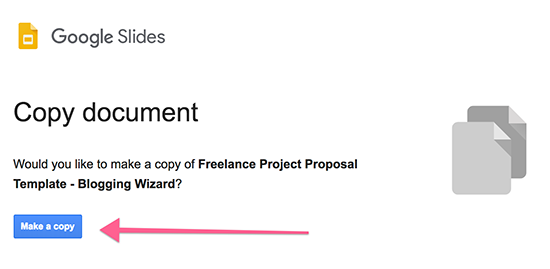
This will create a copy inside your Google account ready for you to edit. Easy!
A few things to consider:
- You need to be logged into your Google account to make a copy.
- If you want to download a Powerpoint version, just click on File > Download to save to your computer.
- The above link to the template page isn’t the direct link to the Google Slides template – this is because the link will be added to multiple posts. If the template is updated and the link changes, this means everyone can easily find the updated version.
This is the standard template that our editor, Nicola, has used to pitch her freelance songwriting services.
This version isn’t written with a specific potential client in mind – it’s used as a starting point that she can expand upon when needed.
As we go through each slide, you may want to create a similar template for yourself to speed up the process of crafting project proposals.
And while this is focused around songwriting services, you can apply it to any other type of freelance service you may want to offer.
#2 – Get your logo and branding colors ready
Great. Now you’ve got the template ready to start customizing.
As we go through each page in the following steps, you should make sure you have the following to hand:
- A high-resolution logo – It will work best if you have a transparent background.
- The hex code for the main accent color of your brand – It looks something like: #2630d9. If you’re unsure what yours is, you can use a color picker extension (like this one for Chrome) to ‘pick’ the color right from your blog.
- The headline and body fonts used on your blog – this is only optional but it’s a nice touch to connect the branding of your proposal to your blog. Not sure which fonts are used on your site? Take a screenshot of them and upload them to WhatTheFont.
The template uses a minimal design to keep more of a focus on your content and to make it easy to customize to your own branding.
For example, one accent color is used so you can go through each slide swap the colors, swap out the logos and fonts, then get to work on the copy.
Easy, right?
#3 – How to change fonts, colors and your logo in Google Slides
Before we dive into the specifics of each slide in the template, I want to quickly touch upon how to go about customizing several elements.
If you’re familiar with Google Slides – you may want to skip to the next section on perfecting your title slide.
How to change fonts:
When you want to change a font, just highlight the text you want to change, then click the font dropdown menu as shown below.
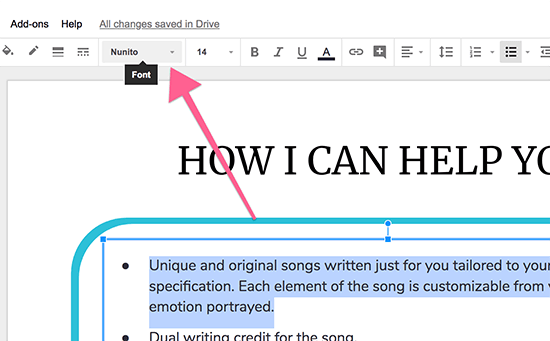
Be sure to change the font to the same font used on your website, or something as close to as possible.
How to change colors:
It’s best to keep the text color the same, but you’ll want to change the accent colors of certain elements.
To change the color of any element, just click on it and you’ll see two boxes appear in the menu above (with the same color as the element).
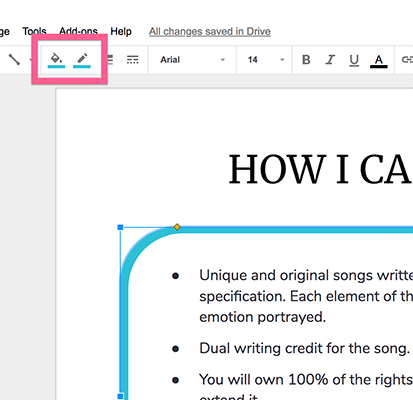
The left box is for the fill color, the right box is for the border color. You’ll want to change the color of both.
Click the relevant button, and a color menu will appear. You’ll then want to select ‘custom’ to enter your own color.

Now, just enter the hex code for your accent color and click ‘ok’.

Then do the same with the other button.
How to add your own logo:
Most logos are added as images, but the logo in this template was created using text and a shape.
If you have a logo, you can upload one by going to Insert > Image > Upload from computer:

Once the logo has been imported, remove the existing logo and arrange yours where you want it to go.
Google Slides will show a red line down the middle of the page when it’s centered.
If you don’t have a logo, you can replace the text with your brand name, and then resize the blue bar below it accordingly.
You’ll want to change the color of the blue bar, and then center the two elements (which can be done by selecting the colored bar + text (highlight one, press shift on your keyboard, then click on the other element).
You’ll then need to drag the elements from left to right until a red bar appears down the center of the page.
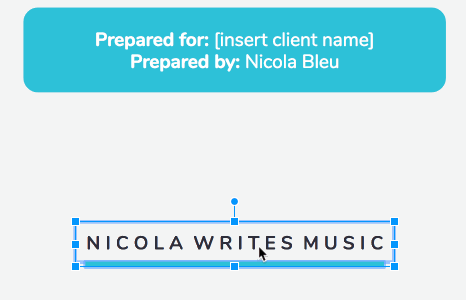
Awesome. Now, let’s go through each of the slides.
#4 – Perfect your proposal title slide (Slide 1)

This is your opener. The first thing a potential client will see of your presentation.
Keep it simple, and to the point – edit the title, names, accent color and logo.
By including your clients name, you’re showing that this proposal was created specifically for them.
And this is important because it shows from the outset that you’ve put time and effort into creating something specifically for them.
You could go a step further and add the clients logo if you have it – but the page may require some rearranging.
#5 – Highlight the benefits of working with you (Slide 2)
Now, let’s cut right to it and show the potential client exactly why you’re the best choice for the job.

Let your potential client know that you have a service offering that can address their specific needs.
This will show that:
- You’ve done your research
- You understand the brand
- You understand the challenges the brand faces
- You understand their audience and its unique connection with the brand
Your exact service offering will be included in a slide later on, so here it’s important to convey benefits as much as possible.
Be sure to keep it concise and avoid injecting unnecessary hype.
#6 – Why should they hire you? (Slide 3)
Your primary value statement should be a strong focus here. And ultimately, your goal here is to prove why a potential client should hire you.
This means building credibility and trust.
But if you’re just starting out as a freelancer, that’s very difficult to achieve.
In an ideal world, you’d have testimonials, client logos, ‘as seen on’ logos, and more.
So, until you have all of those things – do what Nicola has done in her example.
Introduce yourself, your value statement, and convey the passion you have for what you do.
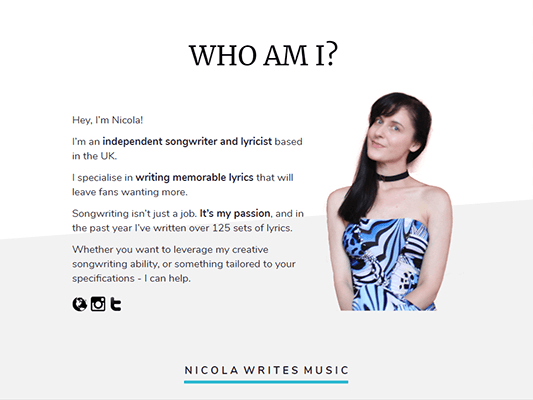
Nicola included a photo of herself which is another important trust factor. You don’t have to do this, but it does help.
You can swap it out the same way you would for your logo (which we discussed earlier).
Briefly talk about any relevant qualifications, experience and anything else that could validate why someone might hire you.
It’s also worth including links to your website and social profiles – some icons have been added to the page already so you can add a link by clicking on each one, and then clicking the link icon in the menu above.
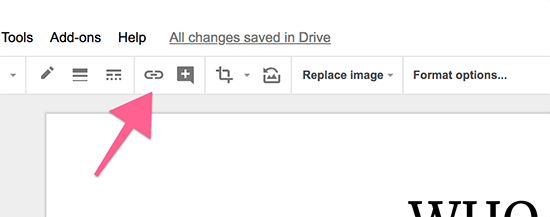
This gives potential clients an easy way to get to know you better on a more personal level. Along with a photo of yourself, it humanizes you and helps to build trust.
Even when you have testimonials and client logos, you may want to add them all to a single page on your website and simply link to that page from within your slide.
This will help to keep your proposal simple, tidy and well refined – giving your words room to breath.
#7 – What are the goals and objectives of the project? (Slide 4)
In your discovery call with the potential client you will have discovered what they’re trying to achieve – their core goal and underpinning objectives.

Start with the core goal – the main thing you will help your client achieve.
Then dive deeper into more specific objectives, and key deliverables.
This is an important slide because it will demonstrate that you have done your research and understand the challenges they face.
Almost every marketing book out there will agree on this:
Researching the brand, its audience, and past literature is critical.
The reason is simple:
When you nail this slide alone, you’ll automatically be ahead of 35% of the US freelance workforce.
#8 – Outline the project process (Slide 5)
At the heart of every great service is a well-oiled process.
It’s this process that enables you to deliver exactly what your client needs, and then some.
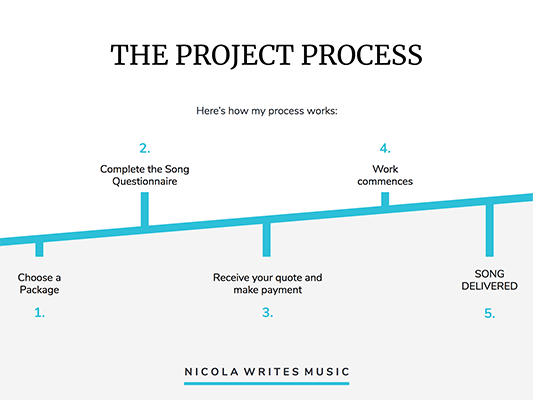
The objective with this slide is clarity – it ensures everyone is on the same page and highlights just how straight-forward it is to work with you.
For more complex service offerings, you may need to duplicate this page and go into more detail.
#9 – Summarise the project objective (Slide 6)
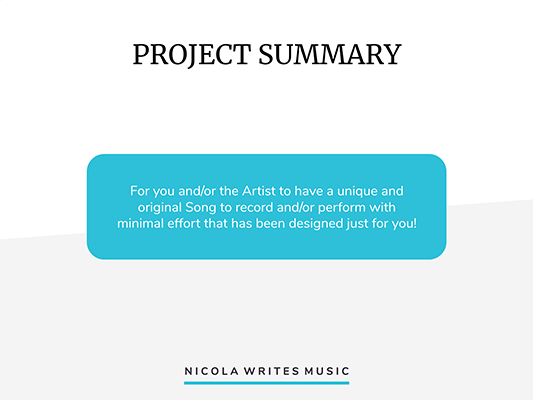
Now it’s time to reinforce your value proposition and summarise the key deliverable(s) of your project.
Keep it simple and this page will have a much bigger impact. Sometimes less really is more.
#10 – Now, let’s talk about your fees and pricing tiers (Slide 7)
In this slide, you’ll breakdown the pricing tiers for your services and mention everything that each package includes.

Pricing your work can be difficult at times. It’s one of those “damned if you do, damned if you don’t” scenarios.
Charge too much and your prospect runs away. Charge too little, and I’m complaining to everyone I know about pricing the gig wrong *sigh*.
Position yourself as the expert because you are the expert. And get paid for your expertise.
In the example slide, we are using a 3 tiered pricing because it gives negotiating room.
Clients can start off smaller to try out your service, and have the option to upgrade. And those that have the budget can go big right away.
Most clients, at least in my experience, tend to lean towards the middle tier.
Good clients understand what they need and the lowest price doesn’t offer all of the benefits. In turn, these clients will pay what you’re worth.
After this slide, you may want to explain each pricing tier in more detail in a separate slide – but it’s not essential.
If you do, you can duplicate one of the other slides that matches closely with how you want each page to look, and drag them to below this one.
#11 – Extra services? Include them here (Slide 8)
Earlier on in this post, we discussed the idea of adding other services to your offering that could be relevant to your target customers.
In this slide, take the opportunity to share other services your potential client may be interested in.
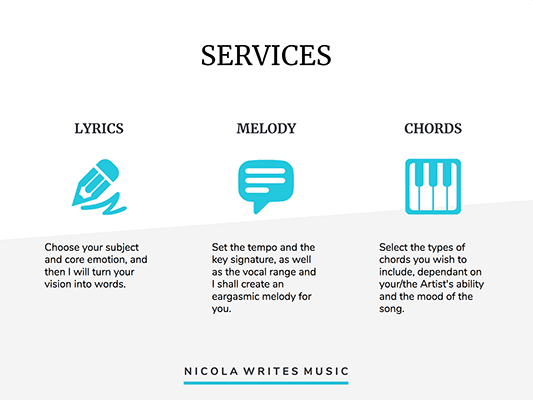
Be sure to include a brief but captivating description below each of your services.
If you don’t have extra services, you may want to remove this slide.
Note: In the example template, Nicola has listed the core components of her main service. She doesn’t offer extra services yet, but we know you might, so we added this slide in as a bonus.
#12 – Invite questions and ask for the sale (Slide 9)
Potential clients will likely have questions, regardless of how much depth you go into.
And others will be ready to get started.
The objective of this slide is simple – invite questions and ask for the sale.
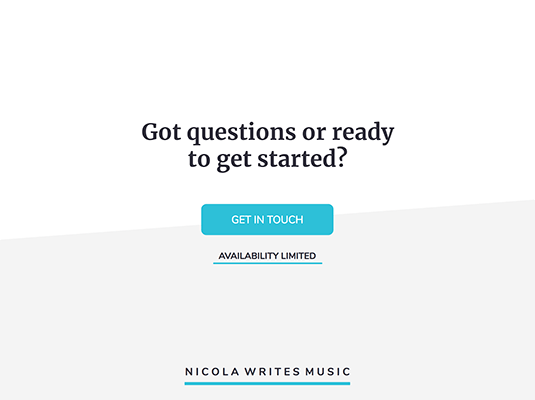
In the example template, we’ve included a button which you can link to your email address or contact page.
You may want to write out your email below the button as well.
Make it easy to get in touch with you – just incase they can’t find your email address.
We also added a scarcity statement; “Availability Limited” to this slide to further encourage potential clients to get in touch.
I know not everyone feels comfortable with using scarcity so you may want to remove it.
That said, the scarcity in this case is valid because your availability is limited.
#13 – Put your stamp on this template
When creating a template, it’s impossible to account for every eventuality.
You may require more slides to accurately convey the value you have to offer.
This is your opportunity to really make this template your own and stand out from the crowd.
Here’s the good news:
You don’t have to start your extra slides from scratch.
Just find an existing slide that has a layout that fits closest to what you have in mind, then duplicate it and drag it to the right place.
Here’s how to duplicate a slide:

#14 – Proofread and export your proposal!
Once you’ve re-read your proposal and fixed up any errors – it’s time to export it.
The best format to use is a PDF because it’s the most accessible.
Go to File > Download > PDF Document to save:
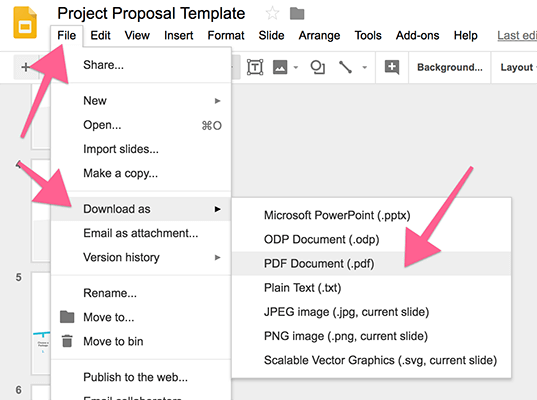
You may want to deliver your presentation via a Zoom call (Zoom offers screen sharing functionality).
Even if you do, it’s always good to have a PDF copy that you can send to your prospective client.
#15 – Aim to get the client on the phone to discuss your proposal
While the last slide in this template invites questions, sometimes you need to be proactive.
Questions are easier to answer over the phone, so aim to get the potential client on the phone.
This will allow you to respond directly to any objections, and answer all of their questions – increasing the likelihood that you’ll close the sale.
Note: If you deliver your presentation via a Zoom call, this may not be necessary because you’ll be able to answer questions there and then. Although, you could schedule a call after the client has had chance to think over your proposal.
Over to you
Getting prospective clients to know, like and trust you is the key to finding and keeping long-term writing gigs.
Bust into the gig economy and stand apart from other writers by positioning yourself as a writer who’ll go the distance to benefit your clients.
Getting better clients and commanding a rate you deserve is easier when you stand out from the pack.
Adopt a positive mindset, nurture relationships with potential clients, and continue to nurture relationships with existing clients.
When you focus on developing and maintaining relationships, it can erase the worry of where the next gig is coming from.
Position yourself as more than a writer by building lasting relationships, adding value and delivering projects that get results.
Now, you’ve got the ideal project proposal template and the tips to help you.
Note: Want our latest content delivered to your inbox? Click here to subscribe to the free Blogging Wizard newsletter.

